Answered step by step
Verified Expert Solution
Question
1 Approved Answer
Write main points from this reading, a summary of minimum 500 words, of the reading below. [Include main take away points, include examples] 352 STRATEGY
Write main points from this reading, a summary of minimum 500 words, of the reading below. [Include main take away points, include examples]
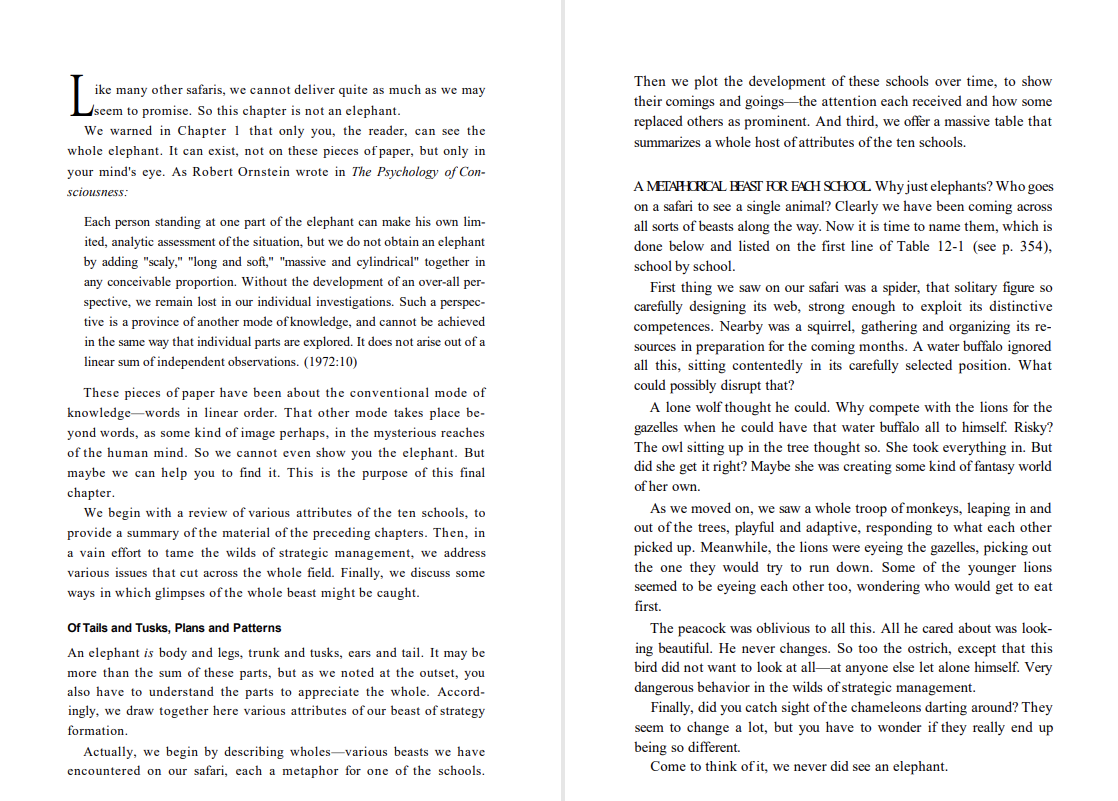
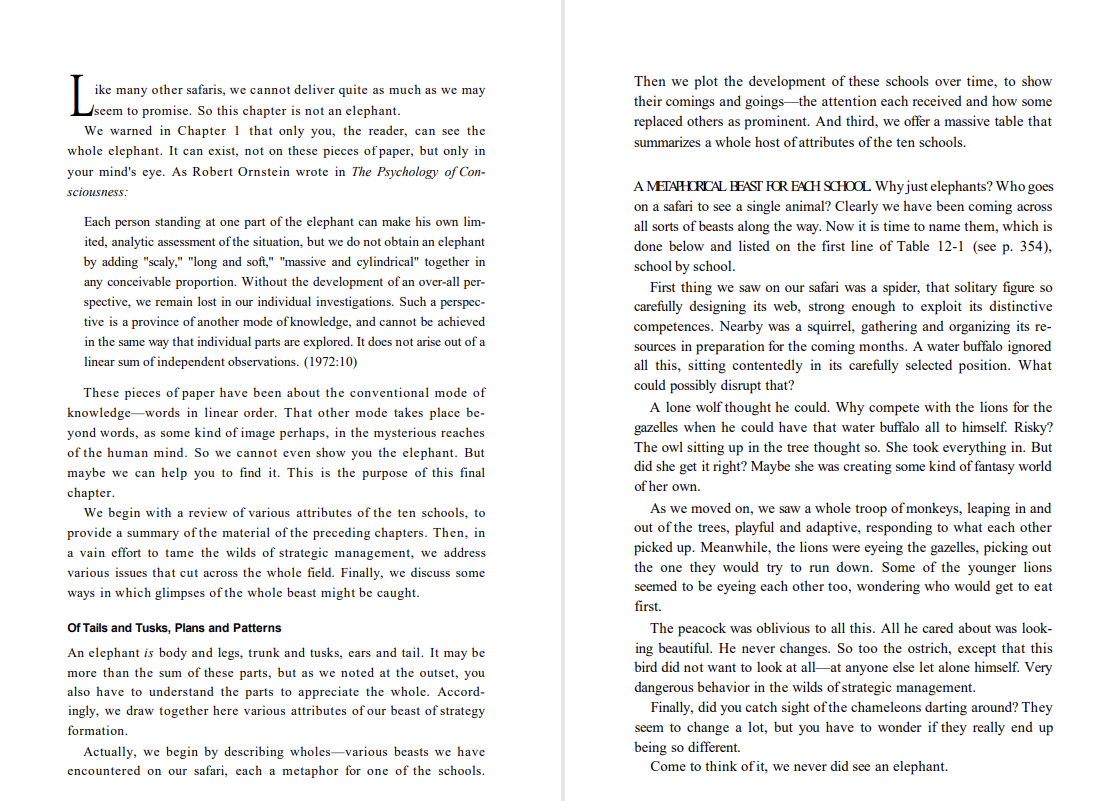

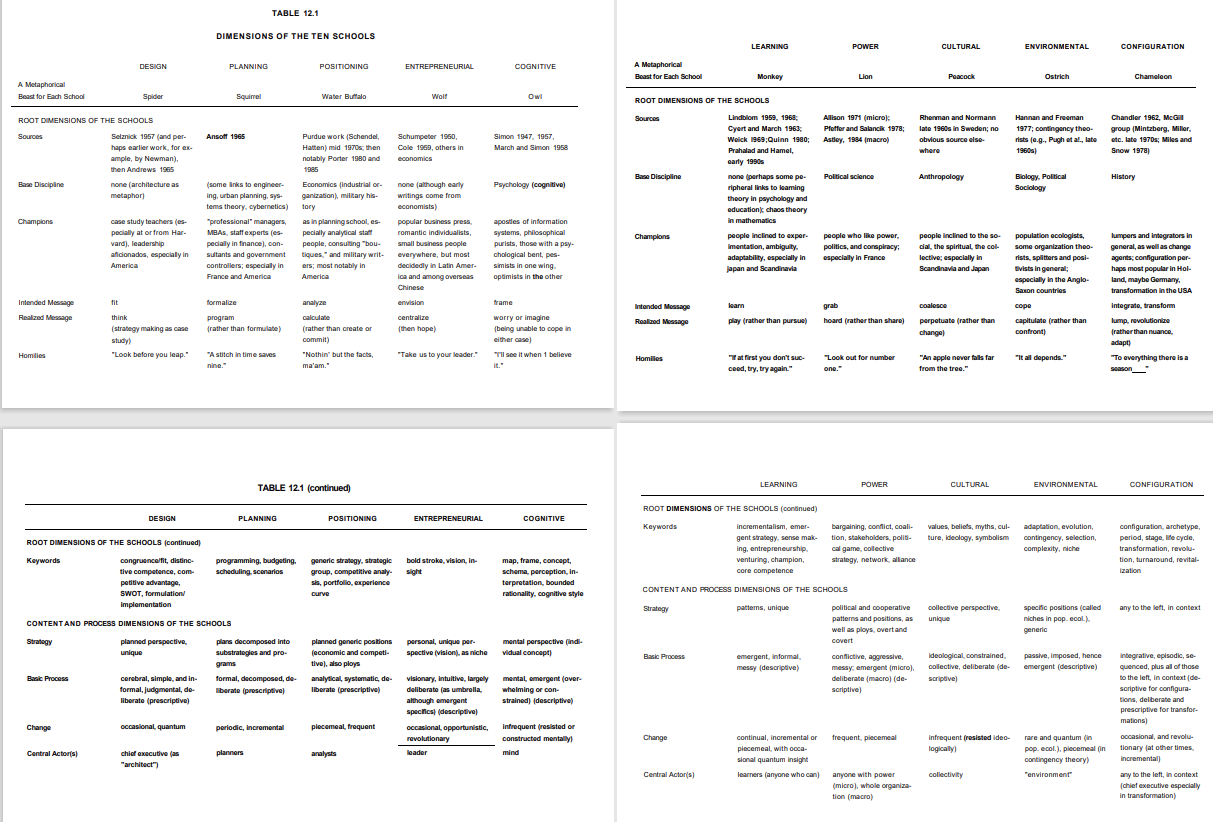

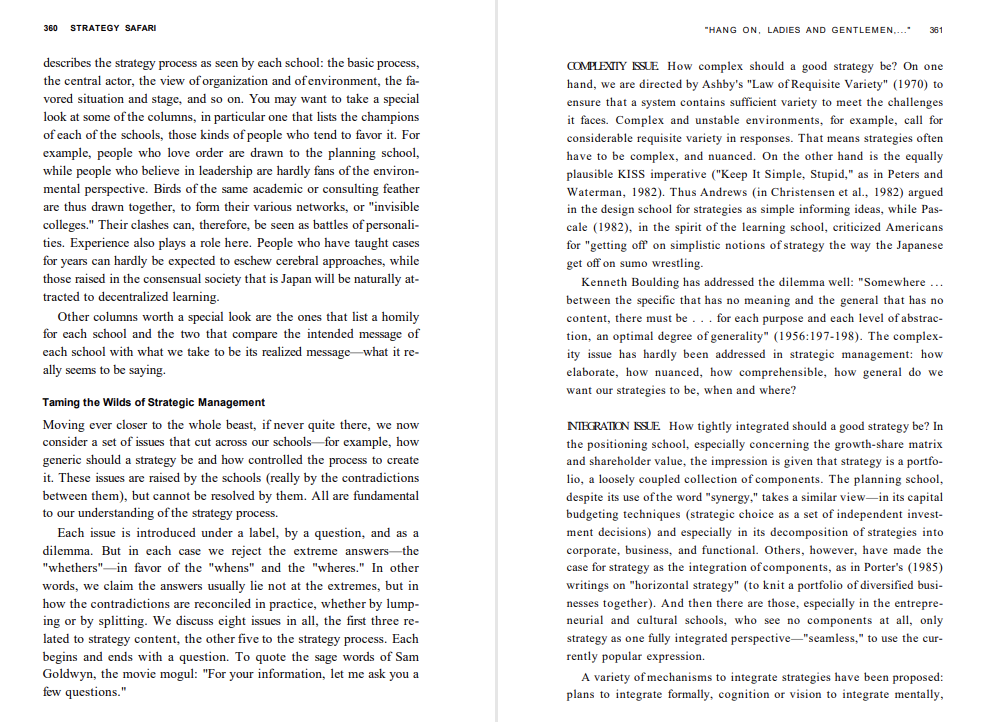

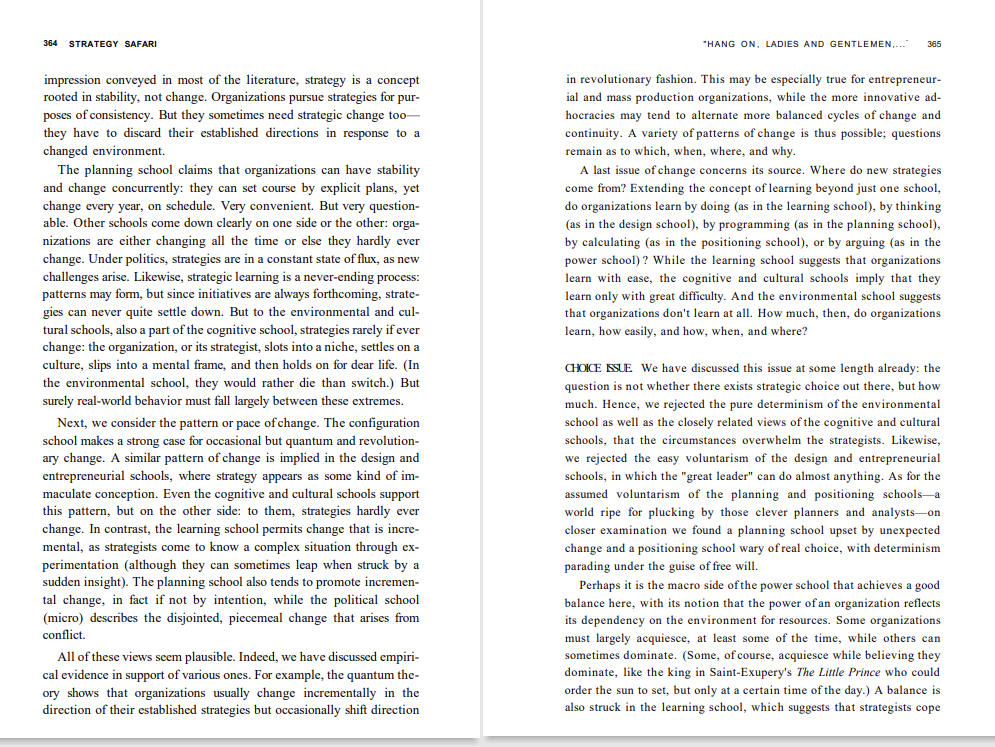
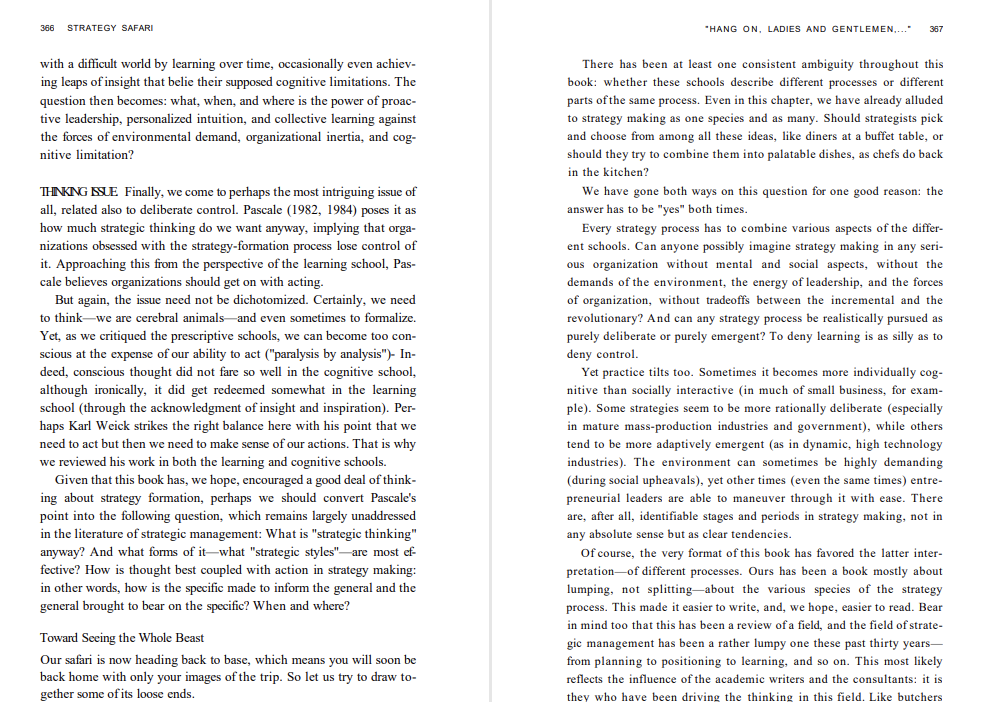
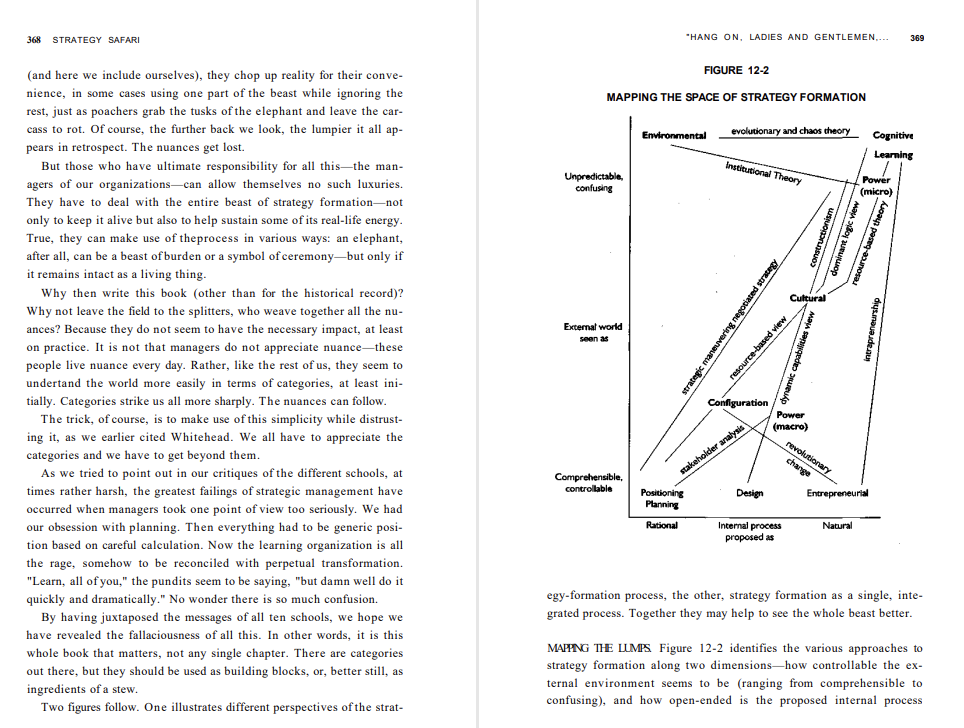
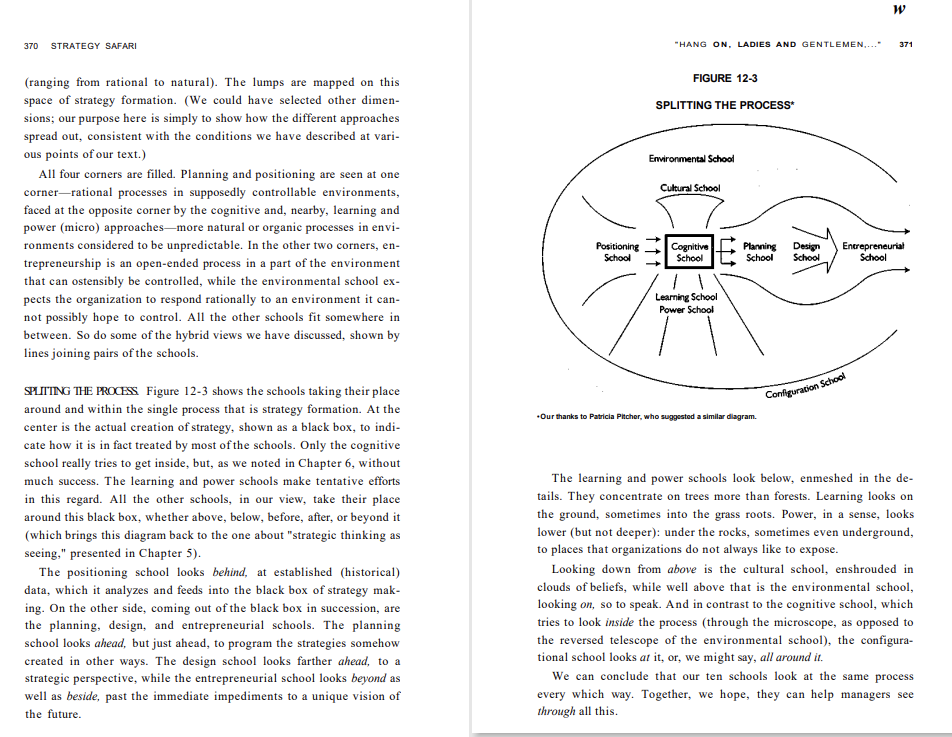

352 STRATEGY SAFARI "HANG ON, LADIES AND GENTLEMEN, 353 THE EVOLUION OF THE SCHOOLS An elephant is a complex system that FIGURE 12-1 grows and develops. That is true of each elephant as well as the species EVOLUTION OF THE TEN SCHOOLS called elephant. The beast that the blind men stumbled upon was the product of a long process of evolution. Imagine, then, the problem biologists have in trying to build a coherent picture of the evolution of all species, from the rather simple to the remarkably complex. Likewise, although somewhat more quickly, the field of strategic management has come a long way since the early 1960s. A literature and practice that grew slowly at first, then faster but in a one-sided way in the 1970s, and another-sided way in the 1980 s, took off on a variety of fronts in the 1990 s. Today it constitutes a dynamic if disparate field. Early schools that were easy to identify have given rise to later ones that are more complex, and more nuanced, one with the other. Figure 12-1 seeks to capture this development by plotting activity in the ten schools. These graphs are impressionistic, our own subjective estimates of the amount of attention each school has received from writers and practitioners. The graphs show the successive dominance of the three prescriptive schools-design in the early years, then planning in the 1970s, followed by positioning in the 1980 s, which has since lost some of its popularity but remains highly influential. In the 1990 s, the field became far more eclectic, with all the other schools gaining in importance. There has been growing attention of late, especially in practice but also in scholarship, to the macro side of the power school, namely alliances, collective strategy, and the like, and in research associated with the cognitive school. But two other schools have really taken off in recent years-configuration and learning. Of course, no one runs around talking about the configuration approach to strategy making-as they did earlier about planning and then positioning. But DMENGONS OF THE SCHOOLS Table 12-1 lists all sorts of dimensions of academics talk a lot about types of strategy processes and stages in the different schools. The table is offered as a summary as well as a refstrategic development, while practitioners in many quarters have beerence source; do not feel obligated to read it all! come almost obsessed with strategic transformation. On a rather dif- Some of this material is for the record-early writers, base disciferent front, learning approaches have come into great prominence plines, key words, and the like for each school. Other material too, especially under the guise of the "learning organization" and "core competence." *Fora time line of some of the main writers, see Gaddis (1997:41). 362 STRATEGY SAFARI "HANG ON, LADIES AND GENTLEMEN,.." 363 culture to integrate normatively, mutual adjustment to integrate colCONIROL SSE How deliberate or emergent should an effective stratlectively, and so on. How much integration is desirable, of what kind, egy-formation process be: how predetermined, how cerebral, how cenwhen and where? tralized? To what extent is there a need for a priori control as opposed to a posteriori learning? We discuss this first among the issues of GENERIC SSUE How unique or novel should a good strategy be? Is the process because it is also one of content-concerning strategies as innumber of available strategies infinite, or is there a "generic" set from tended plans as opposed to realized patterns. (Indeed the more emerwhich organizations must choose? Correspondingly, do organizations gent the strategy, the more a central management must treat content succeed by respecting the rules or by breaking them? The positioning as process-in other words manage people and structures deliberately school tells us that strategies are generic, that they exist a priori, in the hope that they will come up with the desirable strategies.) clearly defined. Strategic positions are like pears, to be plucked off the The three prescriptive schools aggressively promote deliberateness, tree of environmental opportunity. (In the environmental school, the as does the entrepreneurial school (although less formally). One side of pear falls on your head and knocks you senseless.) the cognitive school raises doubts about the power of the strategist's No doubt, there are many industry recipes out there, and no shortmind over strategic matter, while the learning school dismisses the deage of "mainline" and "me-too" strategies. But the entrepreneurial and liberate in favor of the emergent. But, as we noted in Chapter 1 , no cultural schools, in particular, tell us that strategies are unique-perreal world strategy can be purely deliberate or purely emergent, since spectives particular to the vision of one person or the culture of one orone precludes learning while the other precludes control. So the quesganization. No two can be alike. The learning school adds that all tion becomes: what degree of each is appropriate, where and when? strategies are the products of idiosyncratic adaptive processes. And the design school claims that strategies are unique because they are created COLLECTIVE KSUE Who is the strategist? How do we read the "organizain a personalized process of design (even though this school refers retion's mind"? In Table 12-1, we listed the candidates for the job of peatedly to the "choice" of strategy). strategist-each school has its own. At one extreme, it is the him or her So the question becomes not just which is it-novel or genericof the design and entrepreneurial schools; at the other extreme, the when and where, but how do the two interrelate? When and how do them of the learning, political, and cultural schools. Or perhaps the novel strategies become generic, how do strategic groups (as clusters of strategist is the it of the environmental, planning, positioning, and generic strategies) form, and so on? cognitive schools-the world out there, procedure, analysis, or the bi- Note how our three content issues themselves combine. Generic ological brain. To put all this in another way, is strategy formation funstrategies would seem to be simpler, less integrated (as portfolios of damentally a personal process, a technical process, a physiological components), but perhaps more flexible. They are also easier to articprocess, a collective process, even a nonprocess? Maybe it is all of the ulate. Novel strategies are likely to be more complex, presumably above. If so, which, or how much of each, when and where? more integrated, and therefore less flexible (because if you change any part of an integrated strategy, you risk disintegrating it). They may CHANGE ISSUE. Here we really wish to discuss three different issues realso be more difficult to articulate, yet once done, more easily rememlated to strategic change-its presence, its pattern, and its source. bered. Moreover, if strategies are generic, then their content becomes First, how do strategists reconcile the conflicting forces for change the natural focus, while if they are unique, then the focus must turn to and for stability? How do they maintain alignment and promote order, the process of creating them. So let us now turn to the issues of efficiency, pattern, and control, while having to reconfigure and adapt, process. respond, innovate, and learn? To repeat an earlier point, despite the 364 STRATEGY SAFARI "HANG ON, LADIES AND GENTLEMEN,... 365 impression conveyed in most of the literature, strategy is a concept in revolutionary fashion. This may be especially true for entrepreneurrooted in stability, not change. Organizations pursue strategies for purial and mass production organizations, while the more innovative adposes of consistency. But they sometimes need strategic change toohocracies may tend to alternate more balanced cycles of change and they have to discard their established directions in response to a continuity. A variety of patterns of change is thus possible; questions changed environment. remain as to which, when, where, and why. The planning school claims that organizations can have stability A last issue of change concerns its source. Where do new strategies and change concurrently: they can set course by explicit plans, yet come from? Extending the concept of learning beyond just one school, change every year, on schedule. Very convenient. But very questiondo organizations learn by doing (as in the learning school), by thinking able. Other schools come down clearly on one side or the other: orga(as in the design school), by programming (as in the planning school), nizations are either changing all the time or else they hardly ever by calculating (as in the positioning school), or by arguing (as in the change. Under politics, strategies are in a constant state of flux, as new power school)? While the learning school suggests that organizations challenges arise. Likewise, strategic learning is a never-ending process: learn with ease, the cognitive and cultural schools imply that they patterns may form, but since initiatives are always forthcoming, stratelearn only with great difficulty. And the environmental school suggests gies can never quite settle down. But to the environmental and culthat organizations don't learn at all. How much, then, do organizations tural schools, also a part of the cognitive school, strategies rarely if ever learn, how easily, and how, when, and where? change: the organization, or its strategist, slots into a niche, settles on a culture, slips into a mental frame, and then holds on for dear life. (In CHOICE ESLE We have discussed this issue at some length already: the the environmental school, they would rather die than switch.) But question is not whether there exists strategic choice out there, but how surely real-world behavior must fall largely between these extremes. much. Hence, we rejected the pure determinism of the environmental Next, we consider the pattern or pace of change. The configuration school as well as the closely related views of the cognitive and cultural school makes a strong case for occasional but quantum and revolutionschools, that the circumstances overwhelm the strategists. Likewise, ary change. A similar pattern of change is implied in the design and we rejected the easy voluntarism of the design and entrepreneurial entrepreneurial schools, where strategy appears as some kind of imschools, in which the "great leader" can do almost anything. As for the maculate conception. Even the cognitive and cultural schools support assumed voluntarism of the planning and positioning schools-a this pattern, but on the other side: to them, strategies hardly ever world ripe for plucking by those clever planners and analysts-on change. In contrast, the learning school permits change that is increcloser examination we found a planning school upset by unexpected mental, as strategists come to know a complex situation through exchange and a positioning school wary of real choice, with determinism perimentation (although they can sometimes leap when struck by a parading under the guise of free will. sudden insight). The planning school also tends to promote incremen- Perhaps it is the macro side of the power school that achieves a good tal change, in fact if not by intention, while the political school balance here, with its notion that the power of an organization reflects (micro) describes the disjointed, piecemeal change that arises from its dependency on the environment for resources. Some organizations conflict. must largely acquiesce, at least some of the time, while others can All of these views seem plausible. Indeed, we have discussed empirisometimes dominate. (Some, of course, acquiesce while believing they cal evidence in support of various ones. For example, the quantum thedominate, like the king in Saint-Exupery's The Little Prince who could ory shows that organizations usually change incrementally in the order the sun to set, but only at a certain time of the day.) A balance is direction of their established strategies but occasionally shift direction also struck in the learning school, which suggests that strategists cope 368 STRATEGY SAFARI "HANG ON, LADIES AND GENTLEMEN,... 369 (and here we include ourselves), they chop up reality for their conve- FIGURE 12-2 nience, in some cases using one part of the beast while ignoring the MAPPING THE SPACE OF STRATEGY FORMATION rest, just as poachers grab the tusks of the elephant and leave the car- cass to rot. Of course, the further back we look, the lumpier it all ap- pears in retrospect. The nuances get lost. But those who have ultimate responsibility for all this-the man- agers of our organizations-can allow themselves no such luxuries. They have to deal with the entire beast of strategy formation-not only to keep it alive but also to help sustain some of its real-life energy. True, they can make use of theprocess in various ways: an elephant, after all, can be a beast of burden or a symbol of ceremony-but only if it remains intact as a living thing. Why then write this book (other than for the historical record)? Why not leave the field to the splitters, who weave together all the nu- ances? Because they do not seem to have the necessary impact, at least on practice. It is not that managers do not appreciate nuance-these people live nuance every day. Rather, like the rest of us, they seem to undertand the world more easily in terms of categories, at least ini- tially. Categories strike us all more sharply. The nuances can follow. The trick, of course, is to make use of this simplicity while distrusting it, as we earlier cited Whitehead. We all have to appreciate the categories and we have to get beyond them. As we tried to point out in our critiques of the different schools, at times rather harsh, the greatest failings of strategic management have occurred when managers took one point of view too seriously. We had our obsession with planning. Then everything had to be generic position based on careful calculation. Now the learning organization is all the rage, somehow to be reconciled with perpetual transformation. "Learn, all of you," the pundits seem to be saying, "but damn well do it quickly and dramatically." No wonder there is so much confusion. egy-formation process, the other, strategy formation as a single, inte- By having juxtaposed the messages of all ten schools, we hope we grated process. Together they may help to see the whole beast better. have revealed the fallaciousness of all this. In other words, it is this whole book that matters, not any single chapter. There are categories MAPPNG THE LMMS Figure 12-2 identifies the various approaches to out there, but they should be used as building blocks, or, better still, as strategy formation along two dimensions-how controllable the exingredients of a stew. ternal environment seems to be (ranging from comprehensible to Two figures follow. One illustrates different perspectives of the stratconfusing), and how open-ended is the proposed internal process 370 STRATEGY SAFARI "HANG ON, LADIES AND GENTLEMEN,... 371 (ranging from rational to natural). The lumps are mapped on this space of strategy formation. (We could have selected other dimensions; our purpose here is simply to show how the different approaches spread out, consistent with the conditions we have described at various points of our text.) All four corners are filled. Planning and positioning are seen at one corner-rational processes in supposedly controllable environments, faced at the opposite corner by the cognitive and, nearby, learning and power (micro) approaches-more natural or organic processes in environments considered to be unpredictable. In the other two corners, entrepreneurship is an open-ended process in a part of the environment that can ostensibly be controlled, while the environmental school expects the organization to respond rationally to an environment it cannot possibly hope to control. All the other schools fit somewhere in between. So do some of the hybrid views we have discussed, shown by lines joining pairs of the schools. SPITING THE PROCESS Figure 12-3 shows the schools taking their place around and within the single process that is strategy formation. At the center is the actual creation of strategy, shown as a black box, to indicate how it is in fact treated by most of the schools. Only the cognitive school really tries to get inside, but, as we noted in Chapter 6 , without much success. The learning and power schools make tentative efforts The learning and power schools look below, enmeshed in the dein this regard. All the other schools, in our view, take their place tails. They concentrate on trees more than forests. Learning looks on around this black box, whether above, below, before, after, or beyond it the ground, sometimes into the grass roots. Power, in a sense, looks (which brings this diagram back to the one about "strategic thinking as lower (but not deeper): under the rocks, sometimes even underground, seeing," presented in Chapter 5). to places that organizations do not always like to expose. The positioning school looks behind, at established (historical) Looking down from above is the cultural school, enshrouded in data, which it analyzes and feeds into the black box of strategy makclouds of beliefs, while well above that is the environmental school, ing. On the other side, coming out of the black box in succession, are looking on, so to speak. And in contrast to the cognitive school, which the planning, design, and entrepreneurial schools. The planning tries to look inside the process (through the microscope, as opposed to school looks ahead, but just ahead, to program the strategies somehow the reversed telescope of the environmental school), the configuracreated in other ways. The design school looks farther ahead, to a tional school looks at it, or, we might say, all around it. strategic perspective, while the entrepreneurial school looks beyond as We can conclude that our ten schools look at the same process well as beside, past the immediate impediments to a unique vision of every which way. Together, we hope, they can help managers see the future. through all this. 372 STRATEGY SAFARI "HANG ON, LADIES AND GENTLEMEN,. 373 BEYQN THE PARTS. It is convenient that strategic management has, for well as perpetuation; it must involve individual cognition and social the most part, slotted so neatly into these ten categories. That has interaction, cooperation as well as conflict; it has to include analyzing made all of our jobs - as writers, readers, researchers, consultants, manbefore and programming after as well as negotiating during; and all of agers - that much easier. Unfortunately, it may not have been the best this must be in response to what can be a demanding environment. thing for practice. Just try to leave any of this out and watch what happens! That is why we are pleased-now that we have completed this book, at least - that the field is becoming more eclectic, more nuThe Hunt for Strategic Management anced. We celebrate its newfound messiness - so much better than its It is now time to leave our safari, also our libraries, classrooms, offices, old order. Some bemoan this. The field is out of control, they say. and retreats, and plunge into the tangled wilds-where we shall need Bring on some sort of dominating "paradigm."* But we have already clear vision to see the real beasts. We should certainly encourage had that, thank you, in the strategic planning of the 1970 s. Was havscholars and consultants to continue probing the important elements ing people running around filling out those silly forms some sort of of each school: we need to know more about tusks and trunks and tails. strategic Utopia? Later everyone had to be obsessively positioning. But, more importantly, we have to get beyond the narrowness of each Now passionately learning, or else constantly transforming. But who school: we need to know how this beast called strategy formation, needs this? We need good practice, not neat theory. The appearance which combines all of these schools and more, really lives its life. of various hybrids of the schools is thus a welcome sign. (Of course, We need to ask better questions and generate fewer hypotheses - to they are hybrids only in our terms. Reverse the perspective, like that allow ourselves to be pulled by the concerns out there rather than famous image of a wine goblet that becomes the profile of a woman, being pushed by the concepts in here. And we need to be more comand the schools become the hybrids.) This means not only that the prehensive - to concern ourselves with process and content, statics and field is coming of age, but also that the practice is becoming more sodynamics, constraint and inspiration, the cognitive and the collective, phisticated. the planned and the learned, the economic and the political. In other The blind men never saw the corpus colossum of the elephant, the words, in addition to probing its parts, we must give more attention to tissue that joins the two hemispheres of the brain. Nor did they see the the whole beast of strategy formation. We shall never find it, never religaments that connect the different bones. But we are beginning to ally see it all. But we can certainly see it better. And so (forgive us): get that perspective in strategic management. Good thing, because It was the gang from strategy without these parts, all elephants would be dead elephants, and all To action much inclined, strategies dead strategies. Who went to find their cagy beast Not that it will be easy. Strategy formation is a complex space. And As they left ten schools behind. ten is a big number for brains accustomed to seven plus or minus two. Cried they, "Having rode on that safari But the fault, dear Brutus, lies neither in the stars nor in ourselves, but in the process itself. Strategy formation is judgmental designing, intuitive visioning, and emergent learning; it is about transformation as "For a related debate, concerning organization theory in general rather than strategic management in particular, see the case proposed by PfefTer (1993,1995) and the counterargument by
Step by Step Solution
There are 3 Steps involved in it
Step: 1

Get Instant Access to Expert-Tailored Solutions
See step-by-step solutions with expert insights and AI powered tools for academic success
Step: 2

Step: 3

Ace Your Homework with AI
Get the answers you need in no time with our AI-driven, step-by-step assistance
Get Started


